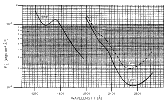![]() for large aperture, high dispersion
for large aperture, high dispersion
where
is related to the inverse sensitivity function (see Figure 3.5), and
is the flux in erg cm¯² s¯¹ ů¹ for a continuum point source or erg cm¯² s¯¹ ů¹ (10 arcsecond²)¯¹ for an extended source.
Estimates of ![]() in erg cm¯² s¯¹ ů¹ may be
obtained from published results of OAO-2 (e.g.
Code and Meade 1979), Copernicus
(e.g. Snow and Jenkins 1977), TD-1
(e.g. Jamar et al. 1976,
or Thompson et al. 1978) and ANS
satellites (Wesselius et al. 1982).
in erg cm¯² s¯¹ ů¹ may be
obtained from published results of OAO-2 (e.g.
Code and Meade 1979), Copernicus
(e.g. Snow and Jenkins 1977), TD-1
(e.g. Jamar et al. 1976,
or Thompson et al. 1978) and ANS
satellites (Wesselius et al. 1982).
The values of ![]() given in Figure 3.5 are based on the
stellar flux calibration used by OAO-2 and Copernicus. TD1 and ANS fluxes are
based on different calibrations. Multiply TD1 and ANS fluxes by the factors
given in Table 3.4 to convert to the OAO-2 scale.
given in Figure 3.5 are based on the
stellar flux calibration used by OAO-2 and Copernicus. TD1 and ANS fluxes are
based on different calibrations. Multiply TD1 and ANS fluxes by the factors
given in Table 3.4 to convert to the OAO-2 scale.
| Wavelength | TD1 | ANS | E( |
| 1380Å | 1.35 | -- | 5.44 |
| 1550Å | 1.37 | 1.35 | 5.04 |
| 1800Å | 1.15 | 1.14 | 4.65 |
| 2200Å | 1.02 | 0.93 | 6.55 |
| 2500Å | 1.13 | 1.02 | 4.19 |
| 2700Å | 1.32 | -- | 3.24 |
| 3300Å | -- | 1.09 | 1.95 |
| Values interpolated from those of Savage | |||
| and Mathis (1979). | |||
 Figure 3.5: IUE inverse sensitivity functions.
(Note: LWR sensitivity curve is for the 4.5 kV configuration and includes the
sensitivity degradation as of mid-1986.)
Figure 3.5: IUE inverse sensitivity functions.
(Note: LWR sensitivity curve is for the 4.5 kV configuration and includes the
sensitivity degradation as of mid-1986.)
Be sure to correct for interstellar extinction when estimating fluxes for reddened stars from those for unreddened stars. Interpolated average normalized interstellar extinction for the TD1 and ANS fluxes are also included in Table 3.4.
=

where
andX =
K = 137,725 for the SWP camera
K = 231,150 for the LWR camera
K = 230,701 for the LWP cameram = the order number, where m = INTEGER[K/
+ 0.5]